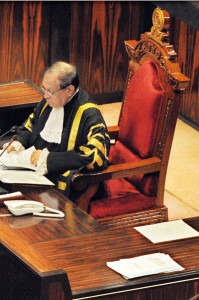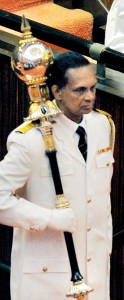Sunday Times 2
History behind the Speaker’s Chair and Mace
View(s):According to the House of Commons Hansard of Dec. 19, 1947, Captain L D Gammons, MP for Hornsby, by private notice, asked the Secretary of State for Commonwealth Relations whether His Majesty’s Government will make the offer of a gift of a Speaker’s Chair and Mace to the Parliament of Ceylon as a token of the goodwill of the House (of Commons) and the British people to the Parliament and people of Ceylon on the attainment of self-government.
The Secretary of State for Commonwealth Relations, Phillip Noel Baker, replied “His Majesty’s Government has decided to offer the gift of a motor car to their Prime Minister.
They have also authorised me to propose to you, Sir, that you should on behalf of this House offer to the Parliament of Ceylon, the gift of a Chair for their Speaker and also of a Mace with our warm congratulations on their attainment of fully responsible self-government, with our best wishes for the happiness and prosperity of their people.”
The announcement was followed by a Motion for an Address to His Majesty King George VI for his consent to the presentations of the gifts. On Dec. 9, 1948, The Speaker read in the House of Commons His Majesty’s answer to the Address giving his consent.
The names of the delegates to make the presentations were announced in the House of Commons by the Herbert Morrison, Lord President of the Council, on Dec. 13, 1948. In pursuance of this motion the delegation consisting of J. Milner, Chairman of Ways & Means, Captain L D Gammons MP and Mayor Lloyd George arrived in the island on Jan. 3, 1949.
On Jan. 11, 1949, the House of Representatives met at 2 p.m. with the Speaker Sir Francis Molamure in the Chair to receive the delegation after which the Sergeant-at-Arms announced: “Mr. Speaker I have to report that a delegation sent by the House of Parliament of Great Britain & Northern Ireland to present a Speaker’s Chair and Mace to the House of Representatives is inquiring whether this Honourable House would be pleased to receive them.”
The consent of the House having been obtained by the Speaker, the Sergeant-at-Arms was directed to admit the delegation. On the entry of the delegation together with the Chair and the Mace the members stood in their places. After those present took their seats, the Speaker welcomed the delegation.
History was made in the House when Mr. Speaker called on Rt. Hon. Milner to speak on behalf of the delegation. At the conclusion of his speech, Rt. Hon. Milner presented the gifts and the House of Representatives reciprocated by passing a resolutions thanking the House of Commons for the gifts.
The Mace
The design of the Mace which measures 48 inches is inspired by the architecture of the ancient temples of Ceylon and the ornamentations based on the lotus. The open lotus is an emblem of eternity and beauty and the closed lotus of perfect peace.
The Mace is composed of a staff of ebony with ornamentation in silver and gold, and the first knob also includes the lotus together with two chased gold bands. Above that is a band of sapphires supporting a longer chased gold band above which is an octagonal silver knob.
This in turn supports four sections in silver and 18 carat gold still in lotus form representing the four quarters of the earth. From this hang four emblems: The sun and the moon symbolic of perpetuity, the Chakra a symbol of progress and bowl of flowers (Porna ghata) symbolic of prosperity.
Above this is the main feature of the Mace — a sphere of silver on which is mounted two chased Sinhala Lions (sehala) with a drawn sword. Above this sphere appears again the lotus, another band of sapphires and an octagonal polished crystal terminal symbolic purity.
Every single feature is worthy of close examination and it will be perceived that the skill of the craftsman has not varied in any degree throughout the work. The movement and life that has been imparted to the graceful petals of the lotus is matched and even surpassed by the fabrication of the silver sphere.
This sphere which is in one piece was brought into being from a flat disc of silver by the process of hammering and gradually causing the metal to take the desired shape. No mechanical aid of any sort has been used in this very remarkable operation.
The whole is indeed a magnificent piece of regalia which represents British craftsmanship. In this piece are seen at its best the craft of the goldsmith and the jeweler and in its entirety is outstanding evidence, that given the opportunity, the British craftsman can accomplish this task. It was done by Garrard and Company, goldsmiths and jewellers to His Majesty the King.
- Nihal Seneviratne
(Original by T. V. Gunatillake, a former Librarian of Parliament)

